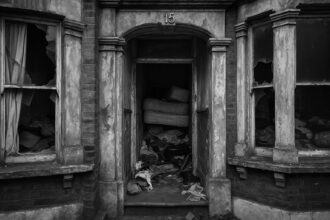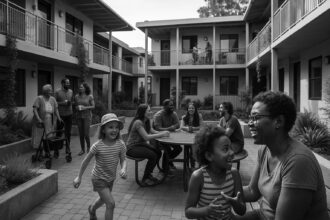A court case in Shetland challenging a 200% council tax on a disputed second home could reshape Scotland’s approach to second-home taxation and clarify what constitutes a main residence.
A couple currently contesting a 200% council tax charge on their Shetland property have asserted that their primary residence is indeed in Shetland, despite often residing abroad due to their work commitments. This contentious situation has led to a court case that could significantly influence regulations regarding second-home taxation across Scotland.
In April 2024, the Scottish Government empowered local councils to double the council tax for second homes, a move intended to curb the trend of property hoarding, thereby making housing more accessible for local residents. Prior to this initiative, second-home owners benefited from a 50% discount on council taxes. Now, for a property classified in Band D, the tax has escalated from £993.50 to £3,974, a steep increase aimed at redirecting housing resources towards residents in need.
West Scotland MSP Ross Greer has voiced strong support for this policy, stating, “Homes are not for hoarding. Everyone should have access to good-quality and affordable homes.” He underscored the urgency of addressing the plight of local communities, where homes remain vacant for most of the year while residents struggle with elevated property prices and limited availability.
In this particular case, the couple has claimed their Shetland house as their main residence, despite being based abroad. The Shetland Council contests this assertion, stating that the couple’s work situation and the time they actually spend in Shetland do not substantiate their claim. Furthermore, the council’s definition of a second home requires that the property is unoccupied for a significant portion of the year, only necessitating occupancy for a minimum of 25 days annually to maintain its status as a second home.
For the couple, the crux of the matter lies in defining “main residence,” a topic that lacked clear judicial interpretation until now. Sheriff Frances McCartney has called for further evidence, indicating that a comprehensive understanding of the couple’s living arrangements and connections to both properties is essential to reach a fair decision. Factors such as schooling, healthcare connections, voting registration, and the presence of personal belongings within the Shetland property are pivotal.
With 221 defined second homes in Shetland, the new council tax policy is expected to generate additional revenue, approximately £240,000 annually, which is intended to support local services. However, the ramifications of this case could extend beyond the couple; should the Tribunal rule in their favour, other second-home owners across Scotland may seek similar legal challenges, claiming their properties as main residences despite limited occupancy.
Critics of the new tax policy have expressed concerns about its effectiveness in solving deeper housing issues facing communities like Shetland. Politicians have remarked that while the objective of increasing affordable housing is commendable, the approach may not genuinely resolve the fundamental problems related to housing shortages. The implications for second-home purchase taxes are also significant, as the Scottish Government recently raised this tax rate from 6% to 8%, creating further financial burdens for potential buyers in the market.
As the court prepares to reconsider the evidence and the interpretative complexities surrounding the classification of a main residence, the future of second-home taxation in Scotland hangs in the balance. The decision from the Upper Tribunal for Scotland is anticipated to clarify not only the couple’s situation but also the broader landscape of housing policy and its enforcement throughout the nation.
Reference Map
- Paragraphs 1, 2, 3, 4, 5, 6, 7
- Paragraphs 1, 2
- Paragraphs 2, 4
- Paragraphs 4, 5
- Paragraphs 2, 3
- Paragraphs 2, 4
- Paragraphs 2, 4
Source: Noah Wire Services
- https://www.pressandjournal.co.uk/fp/news/crime-courts/6756649/but-we-live-here-family-protests-200-second-home-tax-in-court-row/ – Please view link – unable to able to access data
- https://www.shetland.gov.uk/council-tax/discounts-exemptions/2 – Shetland Islands Council has implemented a 100% supplement (200% charge) on second homes from 1st April 2024. A second home is defined as a property that is no one’s sole or main residence but is furnished and occupied for at least 25 days in any 12-month period. The council provides application forms for declaring a property as a second home and for informing them when the 25-day threshold has not been met.
- https://www.gov.scot/news/council-tax-premium-on-second-homes/ – The Scottish Government has introduced legislation allowing local authorities to charge up to double the full rate of council tax on second homes, effective from 1 April 2024. This change aims to prioritize housing for living in and address housing pressures caused by the prevalence of second homes. The legislation received majority support in a joint consultation with the Convention of Scottish Local Authorities (COSLA).
- https://www.shetnews.co.uk/2023/04/19/plans-to-double-council-tax-for-second-home-owners-unlikely-to-tackle-deeper-housing-issues-politicians-say/ – Local politicians in Shetland have expressed concerns that the Scottish Government’s plan to enable councils to charge significantly more council tax on second homes may not effectively address deeper housing issues in the region. The proposal aims to increase the number of affordable homes by allowing councils to charge up to double the full rate of council tax on second homes, bringing it into line with long-term empty homes.
- https://www.gov.scot/news/council-tax-on-second-homes/ – New powers enabling councils to charge up to double the full rate of council tax on second homes have come into force in Scotland. As of 1 April 2024, 29 of Scotland’s 32 local authorities have confirmed that second homeowners will have to pay the higher charge in their areas. The changes aim to help increase housing availability by encouraging more homes to be used for living in.
- https://www.aberdeenshire.gov.uk/council-tax/second-home/ – Aberdeenshire Council has implemented a 100% increase in council tax charges for second homes, effective from 1 April 2024. A second home is defined as a property that is no one’s sole or main residence but is furnished and occupied for at least 25 days during any period of 12 months. The council provides information on how to apply for second home classification and details about the new charges.
- https://www.edinburgh.gov.uk/council-tax/second-home-council-tax – The City of Edinburgh Council has approved a double charge for council tax on second homes, effective from 1 April 2024. This change brings second homes into line with council tax policy on long-term empty homes and aims to increase housing availability by encouraging more homes to be used for living in. Properties classified as second homes are those that are lived in for 25 days a year or more, are furnished, and are not anyone’s sole or main residence.













